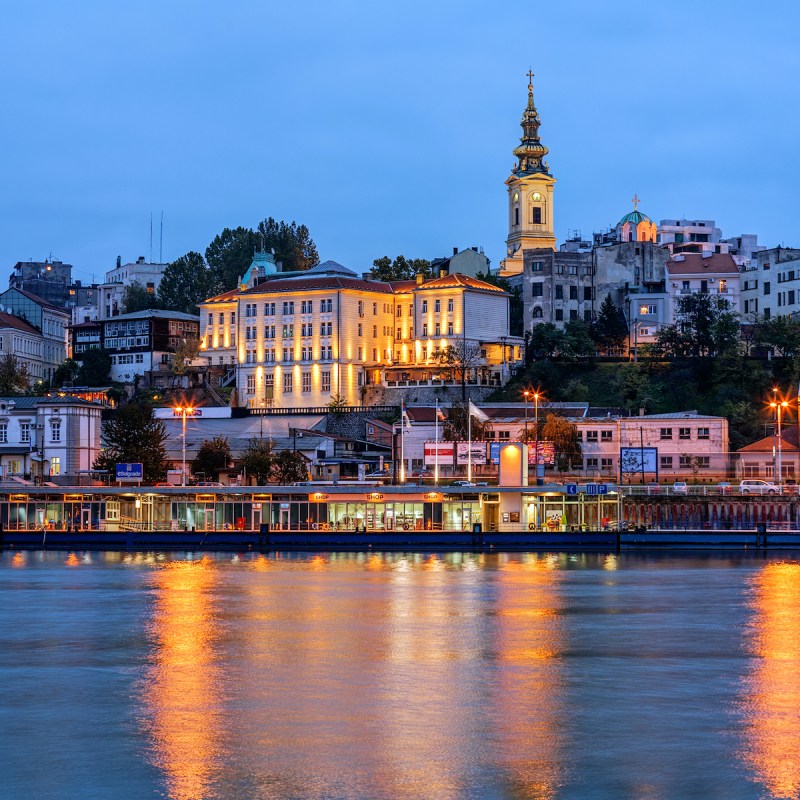
As you already know from my article on waterfront cities around the world, I love a city — the bigger, the better — set by the water, be it an ocean or a grand river. And it doesn’t get much grander than the Danube. The second longest river in Europe after the Russian Volga, the Danube springs in the Black Forest in Germany, and it crosses 10 European countries along its 1,770 miles until it flows into the Black Sea. Not surprisingly, it is popular for river cruises.
Videos by TravelAwaits
There are four magnificent capital cities located on its riverbanks: Vienna, Bratislava, Budapest, and Belgrade. To add to this impressive list, both Bucharest and Sofia lie within a short distance from the banks of the Danube. They are so close, indeed, that river cruises along the Danube stop and allow passengers to visit both capital cities, as well as tourism boards offering day trips from each city to the Danube for river trips to the estuary. So I took the liberty of adding those two cities to this list of wonderful capital cities along the Danube.
While each of the cities has the Danube in common with the others, these capitals couldn’t be more different from each other, each offering distinct history within a unique setting, and each having its own language, cuisine, and atmosphere. Having visited each one, I find it impossible to choose a favorite, as I like them all for specific reasons.
Read my list of cities, starting in the west and moving east to find out what they are and what they have to offer and see if you will end up with a favorite.

1. Vienna
Austria
Vienna barely needs an introduction with its imperial buildings, glorious churches, pretty and very well-behaved Lipizzaner horses, famous cake, and so much art and culture. For art lovers, the Museum of Applied Art and the Hundertwasserhaus are a must, for music and palace fiends, a concert at Schönbrunn Palace is wonderful, and free once a year, while food lovers need to come prepared.
From the famed Sachertorte to the creamy coffees, from Wienerschnitzel to the Naschmarkt (snack market), a huge food market, there is something delicious at every corner. Best bring outfits with elasticated waists or work some of it off walking along the Danube. But do take note that you need to take the metro line U1 to Alte Donau and walk from there, as the Danube is not actually right in the city center of Vienna.
Pro Tip: On my first visit to Vienna, I was a poor student and could not afford tours or guides. Instead, I bought myself a day ticket for the public transport and hopped on every tram I saw, riding it from beginning to end, enjoying the views, listening to the locals chat, and hopping off whenever I spotted something interesting. It still works very well today, especially since Tram 1 is worthwhile riding.

2. Bratislava
Slovakia
Less than 50 miles from Vienna, in the southwestern corner of Slovakia lies its capital Bratislava. With a population of less than half a million and a perfect little old center, Bratislava is perfect for a weekend or a 2-day trip. With most of its attractions located within the old medieval center dominated by the main square surrounded by Gothic and Neo-Baroque buildings, you can get everywhere in Bratislava on foot — even up to the castle. Although if you want to avoid the meandering and easy, but quite numerous steps uphill, take bus number 203 or 207 to the top.
The old town center is strewn with countless quirky sculptures: a guy peeping out of a manhole, a paparazzo taking a picture around the corner, a soldier sitting on the main square’s bench, and many more. Perfect for posing for silly pictures.
Full of cafes and restaurants, art galleries, little stores, and the prettiest blue church, Bratislava is a delight to discover.
Pro Tip: Amidst the old sights, you can also go super modern with a ride up the UFO Bridge across the Danube. This space-age tower allows for fabulous views across the city and surrounding mountains and has a rather good restaurant at the top as well, (with toilets with a view!), but book ahead.

3. Budapest
Hungary
Roughly 125 miles further east of Bratislava lies the wonderful Budapest, offering two cities in one: Buda on the west side of the Danube and Pest on the eastern riverbank. This is, with Vienna, the grandest city along the Danube, with magnificent architecture (the Parliament Building alone, the world’s largest, is worth a visit) ranging from Baroque to Art Nouveau to Socialist Classicism, and lots more.
While Budapest is most famous for its bridges, castle, and ice cream (yes, ice cream), I enjoyed the old Central Market Hall with its great food stalls, the funicular up to the castle, and the Gellert Baths best. The baths offer a great look at and into the Hungarians, with swimming costumes optional in the showers, and massages being approached not with candles and whale song, but in a no-nonsense manner that scared me a little at first but felt good afterward.
Pro Tip: Eat at Hilda Restaurant, a stunning little place serving great Hungarian cuisine — from goulash to paprika chicken — and regional wine. It’s not the cheapest but is probably one of the most stylish.

4. Belgrade
Serbia
Belgrade, some 235 miles from Budapest, is one of those European capital cities that is barely on any overseas visitor’s radar. Lying on the confluence of the Sava River and the Danube, the city is full of history, charming neighborhoods, and some truly superb restaurants serving great food at — for visitors — ridiculously low prices.
With its turbulent history (the last war only ended in 1999), the city is a hotchpotch of buildings dating to the Romans, the Middle Ages, and everything since. Here is an imposing fortress to explore with the best views across the confluence and the surrounding countryside, while the old town Stari Grad is an atmospheric quarter to meander, and Skadarlija street is a perfect stop for food and drink.
To get the most out of the Danube, head to the absolutely gorgeous town of Zemun in the northwest of Belgrade, and then walk back into Belgrade along the Danube. There are plenty of cafes and restaurants, stalls, and sights along the way.
Pro Tip: Just before you reach the bridge back across the Sava, pop into the interesting Contemporary Art Museum.

5. Bucharest
Romania
These last two additions to the list of capitals along the Danube don’t lie on the Danube, strictly speaking. But Bucharest is located less than 50 miles from the Danube, and excursions on the river and toward the estuary, plus stops of the busy river cruises are all practically on the doorstep. And Bucharest is a stunning city with the moniker Paris of the East, and you will soon discover why it is called that. Not only are the buildings grand and beautiful, but also there is an Arc de Triomphe (Arcul de Triumf), and the street signs are of the same blue and green enamel design as those in Paris. Beautiful tiny churches (do pop into every single one, please, otherwise you will miss out) contrast with the imposing buildings of the People’s Palace and the Athenaeum, and the Old Town is surrounded by green parks. A strange but worthwhile site is the Dimitrie Gusti National Village Museum, an eclectic but interesting collection of historic rural houses.
Pro Tip: Don’t miss Carturesti Carusel, one of my favorite bookstores ever.

6. Sofia
Bulgaria
Less than 100 miles from the Danube and very much linked with Danube tourism, Sofia is a small capital with so much to see. Ancient history, stunning Russian Orthodox churches, fabulous art galleries, and even vast Roman ruins which historians — and I — stumbled upon by pure chance. There are amazing restaurants and bars, including one that became my local for the time I was there: The Cocktail Bar on Angel Kanchev Street, with garden seating, where you could sit outside and just enjoy being part of Sofia’s people.
Sofia is a very liveable city, and while not huge on obvious tourist attractions, there are so many smaller things to see, that this might even be my favorite of the lot. Together with Bucharest. And Bratislava. And. Oh, never mind. Every single of these cities along the Danube is beautiful in its own right and well worth a visit.
To double-check, you can “mop up” most of them in one single cruise, and then add some more, by sailing back from Sofia on the Danube to Prague, sailing past — and stopping off at — Belgrade, Budapest, Bratislava, Vienna, through Germany, but then turning off into the Vlatava to Prague.
Pro Tip: If you stay in the Sofia Hotel Balkan, a Marriott Hotel, you not only have the ancient St. George Rotunda out back, but also the main shopping drag Vitosha Boulevard, and the gorgeous Sveta Nedelya Church right on the doorstep.
For more on travel in Europe, explore these articles:

